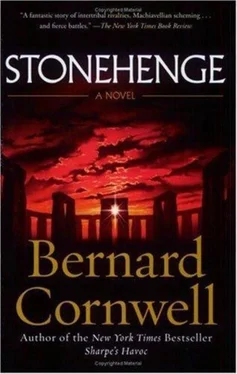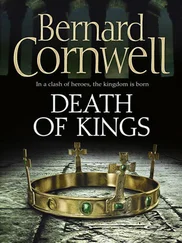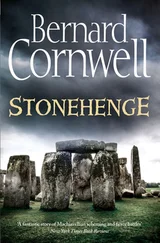But however the stones were fetched, the extraordinary journey was made, and then something even more remarkable happened. The builders, having gone to immense trouble to move the stones from present day Pembrokeshire to Wiltshire, then decided that their new and still unfinished temple was unsatisfactory. They demolished it. The stones were taken away (except, probably, for the Altar Stone, which I have called the mother stone, and which also came from Pembrokeshire, from the bank of the River Clewydd near Milford Haven) to be replaced with the most prominent stones we see today: the sarsen stones. 'Sarsen' is not a technical name, but a local nickname, perhaps derived from 'Saracen', denoting the strangeness of these great grey sandstone slabs that once covered the downs close to Avebury. The stones that make Stonehenge came from the hills just to the east of Avebury and had to be dragged over twenty miles to their present position. It was not such a remarkable journey as the bluestones, but still an incredible feat, for the sarsens were much bigger and heavier (the heaviest weighed over forty tons). They are also among the hardest stones in nature, yet the builders shaped these vast boulders to make the five soaring trilithons and the sarsen circle with its wondrous ring of thirty lintels lifted to the sky. They also rearranged the stones in the main entrance, of which only one remains, the recumbent Slaughter Stone, which probably had nothing whatever to do with any slaughter. The name was given because of a reddish stain on the stone's surface which was assumed to be ancient blood, but is nothing more dramatic than oxidised metal dissolved by rainwater. It is at this point that the novel ends.
Could it all have been done within the compass of one man's lifetime? It is possible, and the radiocarbon dates (mostly derived from scraps of antler picks abandoned in the stone holes) are scarce and confusing enough to allow for the possibility, but most scholars would plausibly argue for a much longer period. I do not believe, however, that building Stonehenge was a leisurely pursuit. There is evidence that some of the stones were erected hurriedly (by being placed in holes too shallow to support them, whereas a painstaking process would have demanded that a longer stone be fetched and substituted), and unchanging human nature alone suggests that when a great work is undertaken there is an impatience to see it finished. I am convinced, also, that the design of the sarsen Stonehenge betrays an architect. The lintels and trilithons may have been copies of wooden originals, but the monument is nevertheless unique and daring, and suggests that someone designed it, and undoubtedly that designer would have been eager to see his idea finished. For all those reasons I suspect that the building took less time than is commonly assumed.
Yet Stonehenge itself was not finished when the great sarsens were installed. At some time, we cannot tell when, carvings of axes and daggers were hammered into some of the pillars. Then, just after 2000 BC, the discarded blue-stones were brought back. Some were placed in a circle inside the sarsen ring while the rest were made into a horseshoe within the trilithons. That ended the building process and the ruins we see today are the remnants of that Stonehenge, though some two or three hundred years after the return of the bluestones more holes were dug for a completely new double ring of stones that would have encircled the lintelled sarsen ring, but those stones were never erected. It was about the same time that the sacred path, the approach avenue which has mostly been ploughed into oblivion, was extended in a great curve to the river bank. Then, around 1500 BC, the temple seems to have been finally abandoned, and it has weathered and decayed ever since.
I have mentioned my considerable debt to John North's book, Stonehenge, Neolithic Man and the Cosmos (HarperCollins, 1997), and I borrowed the configuration of the abandoned bluestone henge from his suggestions. I found Aubrey Burl's books to be just as useful, specifically The Stonehenge People (J. M. Dent, London, 1987), and Prehistoric Avebury (Yale University Press, 1979). The best single introduction to the monument is David Souden's beautifully illustrated and comprehensive Stonehenge, Mysteries of the Stones and Landscape (English Heritage, 1997). I am also indebted to Rodney Castleden's The Making of Stonehenge (Routledge, London, 1993), and to the magnificent, cumbersome and awesomely expensive Stonehenge in its Landscape, Twentieth-century Excavations, edited by R. M. J. Cleal, K. E. Walker and R. Montague (English Heritage Archaeological Report 10, 1995). Lawrence Keeley's War Before Civilization (Oxford University Press, 1996) was most helpful. It is said that a picture is worth a thousand words, but Rex Nicholls's pictures, which illustrate the part-title pages of this book, are worth many times more. My thanks to him, and to Elizabeth Cartmale-Freedman who did much valuable research for me into late neolithic crops, living conditions and the findings from other archaeological sites. The errors, misjudgements and idiocies are all my own.
What makes Stonehenge so special? Some folk are disappointed by the ruins. Nathaniel Hawthorne, visiting the site from his native New England in the mid nineteenth century, wrote that Stonehenge was 'not very well worth seeing… one of the poorest of spectacles; and when complete it must have been even less picturesque than now'. Perhaps, yet most visitors do find the stones awe-inspiring. For some people it is the association, over ten thousand years, of one spot of our planet with humankind's spiritual longings. For others, it is the marvel of the lintels, unique for their time and still breathtaking in their architectural daring. That the monument survived at all is a miracle; over the years some stones were broken and taken away for building projects, while other stones, insufficiently buried, toppled in gales. Yet the temple stands to this day, the names of its gods forgotten and the nature of its rituals a mystery, yet still a shrine for whatever aspirations we cannot answer by technology or human effort. Long may it remain.
Конец ознакомительного отрывка
Купить книгу












